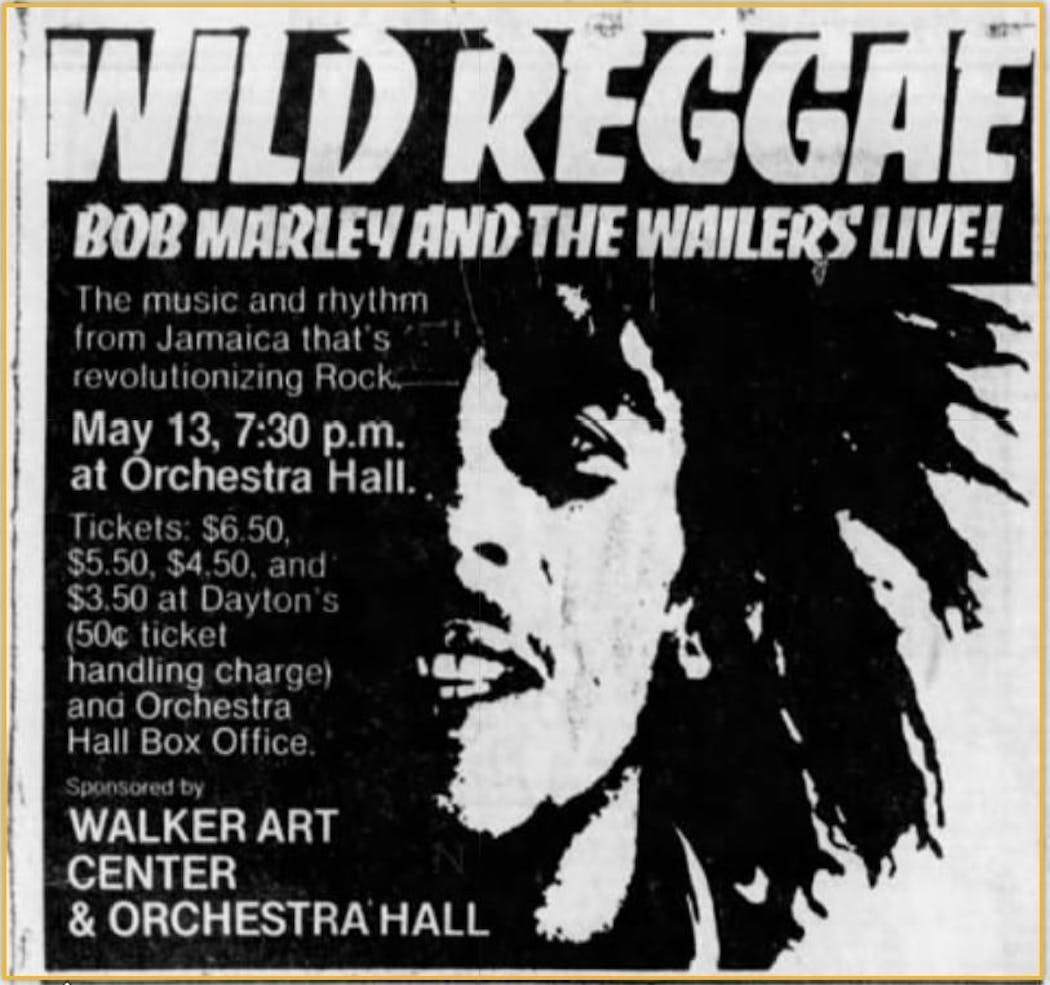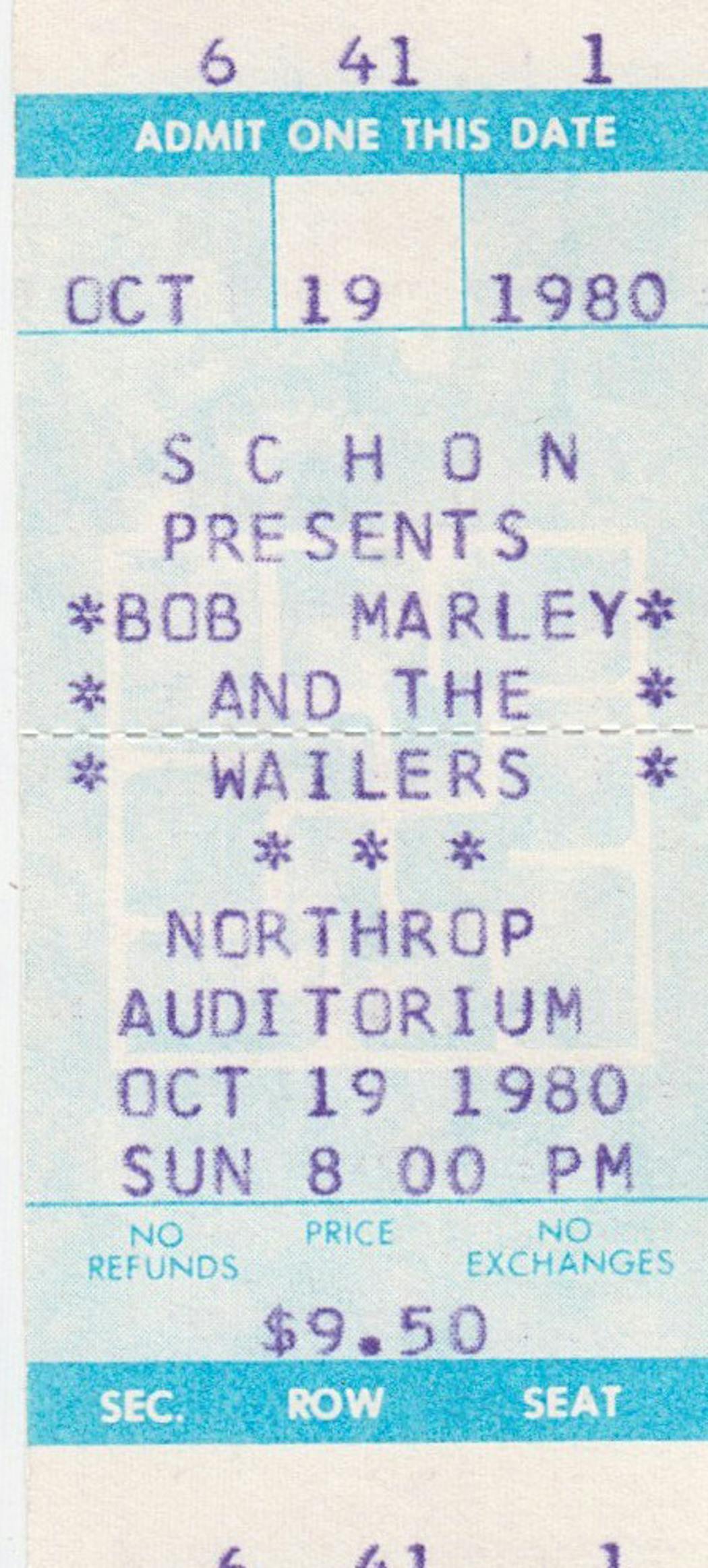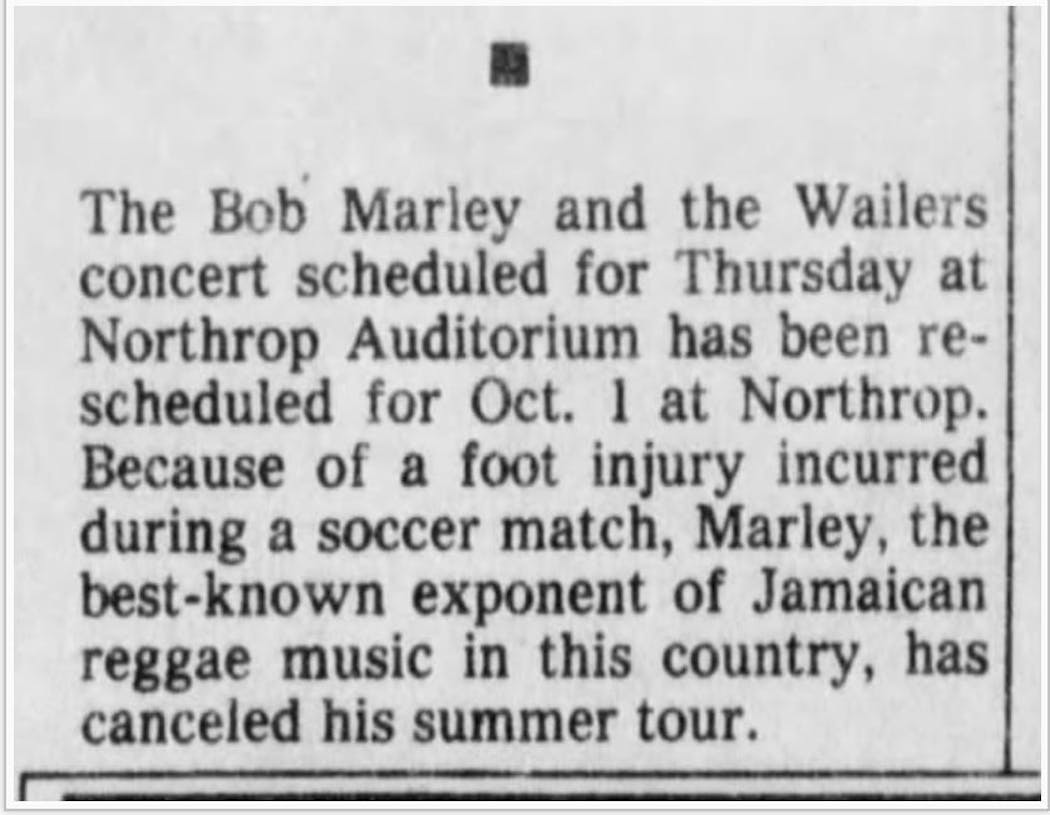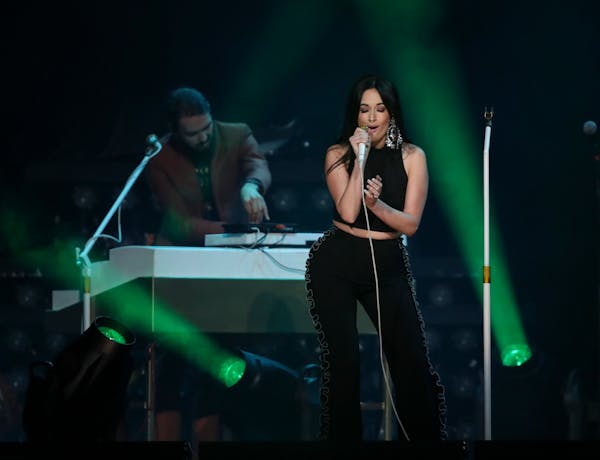Everyone seems to remember his movements the most. How he jumped, swayed and swung his long dreadlocks to the music, not so much performing the songs as embodying them.
They remember all the smoke, too, of course. He and his crew apparently had no trouble finding marijuana way out in Middle America in the late 1970s, nor any qualms about smoking it here.
At least a few Twin Citians have stories of one-on-one interactions with the international icon, remembering how he was smitten with views of the Mississippi River, and how he took time to play a local musician's demo tape in his limousine.
With the 27th annual Bob Marley Remembered tribute concerts returning Friday and Saturday to the Cabooze — bringing all the sunshine and good vibes that can be mustered in a dark Minnesota club in winter — it seems a good time to remember that Marley himself actually performed in Minneapolis.
In fact, he played here three times from 1976 to 1979. He was due back for a fourth show in October 1980, but the cancer that would take his life seven months later at age 36 forced him off the road a month earlier.
Those lucky enough to see him in that short four-year window mostly agree it was unlike anything they'd seen before or since.
"He was just electric," said Don Hughes, a U of M student in 1979 who later became a stage manager at the two local venues to host Marley, Orchestra Hall and Northrop.
"He was very spontaneous compared to most performers," added Hughes. "You could tell he was deep into the music, and the music seemed to come from a different, deeper place."
"I remember he definitely had this special kind of presence," concurred Ryan Cameron, who was then a record-store clerk at Musicland and later opened Let It Be Records. "He really was awe-inspiring."
For many younger fans, it's genuinely awesome just thinking about Marley and his band, the Wailers, being in our midst way up here on the prairie.
Sure, it'd be cool to brag about attending Jimi Hendrix's Minneapolis Auditorium show in 1968, or Buddy Holly and the Winter Dance Party's date at St. Paul's Prom Ballroom in 1959. But unlike those soon-to-be-deceased rock legends, Marley grew into a significant political force worldwide (especially in Africa) and a religious figure, too (integral to Rastafarianism).
"He's a big reason I'm proud to be a Jamaican living in Minnesota," said Lynval "Golden Voice" Jackson, the Kingston-reared frontman for the International Reggae All-Stars, house band for these enduring Cabooze concerts.
With the tribute shows now in their 27th year, Jackson surmised, "Clearly, he left a lasting legacy here."
'What they call Minnesota'
"The music from Jamaica that's revolutionizing rock," read newspaper ads for Marley and the Wailers' Twin Cities debut on May 13, 1976, at Orchestra Hall.
A sign of how reggae was still on the musical fringe then, Walker Art Center co-promoted that first appearance. Tickets were a mere $3.50-$6.50, plus a 50-cent "handling fee" (at a time when buying tickets literally involved handling).
One of Marley's tourmates sounded like a stranger in a strange land as he greeted the crowd that night — probably bassist Aston "Familyman" Barrett, who's still the bandleader for the current touring edition of the Wailers.
"So this is what they call Minnesota, huh?" he hollered to kick off the show, which can be revisited via a surprisingly decent bootleg recording that's easy to find on YouTube. Same with the '79 Northrop gig.
As would be the case for all three Minnesota shows, Marley arrived with the I-Threes as backup singers (including wife Rita Marley) plus a remade Wailers lineup featuring guitarists Junior Marvin and Al Anderson (after co-founders Peter Tosh and Bunny Livingston quit in 1974).
The date fell between shows in Chicago and St. Louis, midway through the 22-city North American leg of their Rastaman Vibration Tour. Songs from the new album of the same name peppered the set list, including "War," "Positive Vibration," "Rat Race" and even the deep-cut gem "Crazy Baldhead."
In his Minneapolis Tribune review, critic Michael Anthony had to explain what reggae is, citing "scratchy, staccato guitar" and "dreadlocks" (the latter actually in quotes). But he insightfully predicted, "If reggae does make a wide sweep into pop music, it surely will be the charismatic Marley who is most responsible."
Anthony's review also brought up a cultural dichotomy that would stick through all of Marley's Minnesota shows: "The white, middle- and upper-class audience who comes to his concerts and sing along are the enemy that Marley sings about."
Partly to attract more of an African-American audience the second time around, the May 30, 1978, show at Northrop featured Little Anthony & the Imperials ("Tears on My Pillow") as the opening act.
In his Minneapolis Star review of that one, Jon Bream took issue with Marley's conversion from tunes about "suffering and political liberation" to "songs of love and togetherness," emblematic of his then-new album, "Kaya." (Don't you just hate togetherness?!)
Still, Bream conceded, "It was uplifting to see the communal spirit cross cultural barriers." The critic also crossed another line of sorts and went backstage to meet the star before filing his review.
"He was sitting on a couch, smoking a rather large joint, and didn't really make much eye contact," remembers Bream, whose only other memory of their conversation is Marley's thickly accented Jamaican patois.
"I didn't understand a word of what he said."
'I love this, mon!'
Another local critic, Martin Keller, landed a substantial one-on-one experience with Marley after his last local performance, Nov. 15, 1979, at Northrop, a show that featured soul singer Betty Wright as the opener.
Taking advantage of an off-day on the tour itinerary, Keller met the reggae star in the penthouse suite at the Radisson in downtown St. Paul for an interview the next day, which became a cover story for Sweet Potato (the precursor to City Pages).
"The experience gave a whole new meaning to the phrase 'high atop the Radisson Hotel,' " Keller writes in his new book with music photographer Greg Helgeson, "Hijinx & Hearsay: Scenester Stories From Minnesota's Pop Life," coming in April via Minnesota Historical Society Press.
More seriously, Keller recalled Marley being "very taken" by the riverfront view from high up, and he said the singer was "friendly, warm and as charismatic in person as he was on stage."
Helgeson took photos throughout the interview. "The discussion at one point was about religion and the Bible, which he was extremely articulate about," Helgeson remembered. "I thought he was a very intelligent guy with a good sense of humor."
He later accompanied Marley to a record signing at the Wax Museum, a shop on Lake Street in Minneapolis. Former employees at Third Stone — more of a head-shop-style store — also remember him stopping in for an appearance at their Lake Street outlet, where they gave the singer a pipe made by their in-house glass blower.
"He arrived late with a bodyguard, but he had a big crowd and stayed and signed a long time," remembered Third Stone staffer Nancy Boran, who still has her autographed copy of "Kaya." Her former co-worker Jeff Bandersky recalled "getting high off the fumes just from standing next to him."
One of those in-stores is where Minneapolis musician Larry Sahagian of the Urban Guerrillas said he handed Marley his demo tape.
"He walks me outside to his big black limo, we go inside, [and] he pops my cassette in," recalled Sahagian. "I'm about to die. He listens and totally gets it, and says, 'I love this, mon!' "
Marley then invited the local rocker — and his rather sizable bag of marijuana — to their soundcheck at Northrop that afternoon. The herbal stash was gone by the time they finished.
"It was 60 to 90 minutes, and the band and I-Threes smoked more than a half-pound of weed between them," Sahagian marveled. "Think about it."
That story is one of several reasons to believe Marley came to like it in Minnesota. He booked his third Northrop show in as many years on Oct. 19, 1980.
Eerily, though, Marley had canceled an earlier Northrop date in 1977. News blurbs at the time chalked up the cancellation rather innocuously to "a foot injury incurred during a soccer match." That injury eventually turned cancerous.
"I had front-row tickets" to the 1980 concert, lamented local drummer and photographer Michael Reiter, who traded in those seats for a show by the Police and XTC after Marley canceled.
Still, Minneapolis can relish being one of the few U.S. cities between the coasts to get three performances before the icon's untimely death. At least in subtle ways, those shows may have opened up Minneapolis and made a lasting impression on the city, which has since become a hub for Caribbean and African immigrants.
"I think [Marley] would be amazed to see so many Caribbean people — or black people in general — living here in Minnesota now, which surprises a lot of other performers who come through here," said Lynval Jackson.
But Jackson also underlined how universal reggae music and Marley's lyrics have become since he first planted them in the far-off wilds of Minnesota.
"The songs he sang then are still the songs people will be singing word for word" this weekend, he said. "They still have as much relevance today as they did back then."




